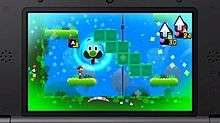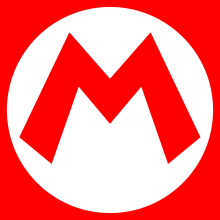Mario & Luigi: Dream Team
Mario & Luigi: Dream Team,[lower-alpha 1] known in Europe and Australia as Mario & Luigi: Dream Team Bros.,[1] is a 2013 role-playing video game developed by AlphaDream[2] for the Nintendo 3DS. Revealed on Nintendo Direct on February 14, 2013,[3] it is the fourth entry in the Mario & Luigi series of Mario role-playing games. In the United States, a download code for the game was included with a silver Mario & Luigi-themed Nintendo 3DS XL.[4]
| Mario & Luigi: Dream Team | |
|---|---|
 Packaging artwork released for all territories. | |
| Developer(s) | AlphaDream Good-Feel (Giant Battles) |
| Publisher(s) | Nintendo |
| Director(s) | Hiroyuki Kubota |
| Producer(s) | Akira Otani Yoshihiko Maekawa Toshiharu Izuno |
| Artist(s) | Akira Noguchi |
| Writer(s) | Hiroyuki Kubota |
| Composer(s) | Yoko Shimomura |
| Series | Mario & Luigi |
| Platform(s) | Nintendo 3DS |
| Release | |
| Genre(s) | Role-playing |
| Mode(s) | Single-player |
The game was one of many Luigi-themed games released during Nintendo's "Year of Luigi" from March 2013 to March 2014, to celebrate the thirtieth anniversary since his original appearance in Mario Bros. in 1983. As a result, Luigi has a larger role in the game than he did in previous installments of the franchise.
The series' final original installment, Mario & Luigi: Paper Jam, was released in 2015.
Gameplay

Dream Team features gameplay similar to previous Mario & Luigi games, in which the player controls both Mario and Luigi, who explore the game's overworld together and fight in turn-based battles. Like the previous games, players can individually control actions with Mario and Luigi to attack and dodge enemies, and learn various 'Bros. Attacks' by finding Attack Blocks. This game uses 3D graphics for backgrounds and pixel art for characters. Players are also now able to save their game anywhere on the overworld, as well as via Save Blocks, and some Bros. Attacks make use of the 3DS' gyroscopic features. The Badge system from previous games is enhanced, allowing players to store multiple badge effects once charged, encouraging players to change their badge combinations to store various effects. If the player loses a battle, they have the option to try on an easier mode and receive optional hints for fighting certain enemies. The rank-system introduced in the previous game was refined as well, now giving players the ability to select certain bonuses upon reaching a new rank such as an additional equipment slot, further stat increases on level-ups or cutting BP cost in half. Some bonuses can only be chosen once later ranks are reached. Due to there being more bonuses than ranks, it is not possible to get every bonus in one playthrough.
The main game takes place in the 3D top-down overworld of Pi'illo Island, where Mario and Luigi can explore the environment and fight side by side in battle. However, in order to rescue the Pi'illo Folk, who have become imprisoned in stone pillows, Mario would have to enter the Dream World via Luigi's dreams. The Dream World takes place in a 2D side-scrolling environment, where Mario is joined by Luigi's dream counterpart, Dreamy Luigi. Throughout these Dream World stages, players find various phenomenons called Luiginary Works, which Dreamy Luigi can interact with. Whilst Dreamy Luigi is embedded in a Luiginary Work, players can interact with the environment by touching the real-world Luigi on the touchscreen. For example, players can tweak Luigi's moustache to manipulate a Luigi-shaped tree to fling Mario to new areas with its branches, or make Luigi sneeze to create a gust of wind that blows blocks into the foreground.[5] A recurring Luiginary Work sees Mario take command of a stack of Luigis known as Luiginoids, which takes on new abilities and forms as the game progresses, such as smashing through blocks, creating whirlwinds and rolling down hills.
Battles are also different inside the Dream World, as Mario combines with Dreamy Luigi and fights against large groups of enemies with assistance from the Luiginoids, which allow him to attack multiple enemies with successful attacks.[3] In place of the Bros. Attacks are the Luiginary Attacks, which also incorporate the Luiginoids, such as tilting the console to steer a rolling ball of Luiginoids to run over an enemy. There are also some sections in which players control a giant Luigi by turning the 3DS on its side and using stylus controls (similar to the giant Bowser battles from Mario & Luigi: Bowser's Inside Story).[6]
Plot
The game opens at the Mushroom Kingdom when Princess Peach, Mario, Luigi, Toad and Toadsworth are flown to Pi'illo Island. There, they meet Broque Monsieur and Starlow, both returning from the previous game in the series, Bowser's Inside Story. Soon after they arrive on the island, the gang gets introduced to Antasma, the bat king, who soon teams up with Bowser. They seek to acquire the Dream Stone, a powerful artifact that grants its user endless wishes. Together, Mario and Luigi must defeat them to save the island while battling enemies and traveling through Luigi's dreams along the way. In the Dream World, Mario meets "Dreamy Luigi", his brother's Dream World counterpart, who helps Mario navigate and battle in the Dream World. They also encounter Prince Dreambert, the ruler of the Pi'illos, who helps them in their quest. Once Mario and Luigi make it to Bowser and Antasma, Bowser reveals he'd been using Antasma the whole time and betrays his partner. He escapes with the Dream Stone, leaving Antasma to be defeated by Mario and Luigi. The Dream Stone is soon destroyed by Peach and Starlow, only for its fragments to be inhaled by Bowser, who transforms into an empowered living nightmare of himself called "Dreamy Bowser". Mario and Luigi defeat Bowser, who turns back to normal, rescue Peach, and finally return to their vacation on Pi'illo Island.
Reception
| Reception | ||||||||||||||||||||||||||||||||||
|---|---|---|---|---|---|---|---|---|---|---|---|---|---|---|---|---|---|---|---|---|---|---|---|---|---|---|---|---|---|---|---|---|---|---|
| ||||||||||||||||||||||||||||||||||
Dream Team received positive reviews for its gameplay, humor, and soundtrack, but some criticisms were drawn towards the overabundance of tutorials and some pacing issues. The game holds a score of 81% on Metacritic based on 75 critics and 294 ratings, indicating "generally favorable reviews".
Dream Team has made 2,000,000 worldwide sales as of December 31, 2013.[18]
Notes
- Known in Japan as Mario & Luigi RPG 4: Dream Adventure (マリオ&ルイージRPG4 ドリームアドベンチャー, Mario ando Ruīji Aru Pī Jī Fō: Dorīmu Adobenchā)
References
- "Twitter / NintendoEurope: Mario & Luigi: Dream Team". Twitter.com. Retrieved 2013-06-07.
- "AlphaDream handling development on Mario and Luigi: Dream Team | GoNintendo - What are YOU waiting for?". GoNintendo. Retrieved 2013-06-07.
- Gaston, Martin (February 14, 2013). "Mario & Luigi: Dream Team announced for 3DS". GameSpot. Retrieved February 19, 2013.
- "Mario & Luigi: Dream Team review".
- Narcisse, Evan. "Finally, Luigi Is MUCH Bigger Than Mario". Kotaku.
- "Mario & Luigi: Dream Team". GameRankings. 2003-07-14. Retrieved 2013-07-14.
- "Mario & Luigi: Dream Team". Metacritic. Retrieved 2012-07-14.
- "Mario & Luigi: Dream Team Bros. Review - IGN". edge. 2013-07-12. Retrieved 2013-07-14.
- "NEW GAME CROSS REVIEW - マリオ&ルイージRPG4 ドリームアドベンチャー." Famitsu. No.1284. Pg.42. 25 July 2013.
- "Mario & Luigi: Dream Team". gameinformer. 2013-08-07. Retrieved 2013-08-07.
- "Mario & Luigi: Dream Team". GameSpot.com. 2013-07-12. Retrieved 2013-07-14.
- "Mario & Luigi: Dream Team review". Retrieved 2013-07-12.
- "Mario & Luigi: Dream Team Review - IGN". 3ds.ign.com. 2013-07-11. Retrieved 2013-07-14.
- Kubba, Sinan (August 10, 2013). "Mario & Luigi: Dream Team review- sometimes a snooze". Archived from the original on January 31, 2015. Retrieved August 10, 2013.
- "Mario & Luigi 4 review". Retrieved July 11, 2013.
- "Mario & Luigi Dream Team review". Retrieved August 7, 2013.
- "Supplementary Information about Earnings Release" (PDF). Nintendo. 2014-01-29. Retrieved 2014-01-29.
